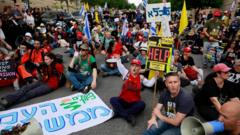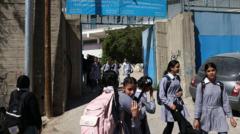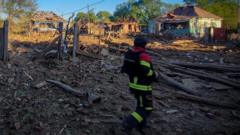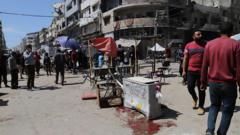The cease-fires in Lebanon and Gaza are appearing increasingly unstable as Israeli forces engage in violent clashes that have resulted in significant casualties in southern Lebanon, while tensions brew in Gaza where Israel restricts movement, citing violations by Hamas.
Tensions Mount as Israel's Cease-Fires in Gaza and Lebanon Show Signs of Collapse

Tensions Mount as Israel's Cease-Fires in Gaza and Lebanon Show Signs of Collapse
Fragile cease-fires in Lebanon and Gaza are tested by escalating violence, with Israeli military actions leading to casualties and the prevention of Palestinian returns, raising concerns of prolonged conflict.
The ongoing cease-fires in Lebanon and Gaza are showing signs of fragility, highlighted by renewed violence and unresolved tensions. Israeli forces have reportedly killed at least 22 individuals and injured over 120 in southern Lebanon, where clashes broke out amid Israeli military operations beyond a previously established 60-day deadline for withdrawal. The violence has sparked fears of a continued Israeli presence and renewed hostilities, contradicting efforts that aimed to bring a lasting peace following a devastating conflict.
On the ground in Lebanon, residents displaced by warfare are attempting to return home to towns along the southern border, despite warnings from both the Israeli and Lebanese military. The Syrian military indicated these returnees, some already facing dire conditions, could encounter further violence, reinforcing anxiety among families separated from their homes for over a year. Some residents report being fired upon by Israeli forces while attempting to enter their villages, describing the overwhelming destruction of their neighborhoods.
In Gaza, a parallel situation unfolds, where Israel maintains strict restrictions preventing displaced Palestinians from heading back north, countering claims from Hamas that it is Israel's obstinacy delaying the return. Accusations fly between the sides, with Israel asserting Hamas has breached cease-fire agreements, while Hamas counters that delays in negotiations are largely due to Israeli actions.
Political dynamics complicate the scenario further as Lebanese leaders, recently elected amid political gridlock, face pressure to assert national control over an increasingly volatile situation. While Hezbollah has traditionally held significant influence in Lebanese politics, the current context—marked by high casualties and the Israeli military's continued presence—poses a critical challenge to its authority.
The conflict is not solely confined to ongoing military operations; it reflects deeply rooted struggles for regional stability, autonomy, and control, as both Israel and Hezbollah navigate complex political landscapes. Mediators from countries like the U.S., Qatar, and Egypt are reportedly involved in seeking resolutions, but the disparate perspectives and strategic aims of the parties involved hinder progress.
As diplomatic efforts continue and both civilians and military actors await developments, the potential for violence and outbreaks of hostilities looms large, signaling a continued struggle for peace in these historically turbulent regions.




















